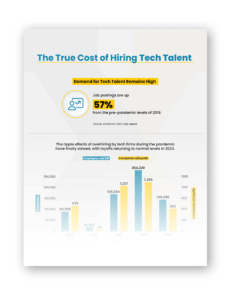The ongoing software developer shortage in the U.S. has brought into sharp focus the need for CIOs to look for better and more sustainable ways for staffing critical roles. The extended period of global instability and insecurity since the beginning of this decade has also seen a growing shortage of skilled software developers. A vital resource needed to keep pace with the rapid advances in technology and to enable digital transformation in traditional industries, the shortage of software developers is only expected to worsen.
IDC predicts a shortfall of four million developers by 2025, while the U.S. Bureau of Labor Statistics expects that almost 165,000 developer jobs will need to be filled each year through the end of the decade.
As a consequence, companies are struggling to fill critical roles. More than one-quarter of companies spend nine or more weeks filling in-demand software engineering, data analytics, data science, and UX design positions, according to a recent report by IT training company General Assembly. Due to difficulties sourcing talent, companies are spending an average of almost $30,000 to fill in-demand tech positions, the report said.
Not surprisingly, CIOs are seeking urgent solutions to this problem, and are turning to mobilizing existing employees – also known as “quiet hiring,” – re-thinking hiring and benefits strategies, and expanding outreach for talent. At the same time, the looming threat of recession is driving businesses to prioritize cost optimization, which in some cases, has led to mass layoffs.
Nearshoring: a strategic and sustainable solution
In this scenario, nearshoring is emerging as a strategic and sustainable long-term solution to bridge the talent gap without being affected by short-term economic trends. The advantages offered by Latin America’s geographic proximity – overlapping time zone, shorter travel duration from the U.S., no or low cultural and language barriers – are complemented by the high literacy rate, large talent pool, robust business infrastructure, and innovation ecosystem cultivated by top nearshore locations such as Costa Rica and Colombia.
Businesses are wising up to this: new delivery center openings by software service firms in Latin America remained strong in 2022.
However, selecting the right partner is critical for a successful nearshoring strategy. Below are a few essential criteria to consider when choosing a nearshoring partner, to ensure they can meet your organization’s current and future software development needs:
1. Experienced provider with mature practice
Do your due diligence when shortlisting potential nearshoring partners, find out how long they have been in the business and their experience in software development and sourcing talent for the practice.
2. Talent quality and scalability
While a low price point is attractive, it should not take precedence over whether your partner has the ability to provide quality talent and can scale team strength up or down as required. Also, examine that the provider is able to provide talent with the qualifications and certifications required for your project needs.
3. Location
Not all nearshoring destinations are created equal. While some, like Costa Rica, have an abundance of high-quality, English speaking software developers available throughout the state, in other states, qualified talent is concentrated around the major cities. Find out, and ideally visit, the locations from which your service provider operates, and learn more about the recruitment methodology and sourcing techniques they use to find the right talent.
4. Customized, flexible approach
A key consideration is whether a provider follows a cookie-cutter approach or is flexible enough to take into account each customer’s unique challenges and requirements. Boutique nearshoring firms like Auxis offer customized, white glove services in this space, always prioritizing quality talent and services over cost, irrespective of customer size.

The long-term benefits that can be gained by working with a trusted, experienced nearshore software development partner like Auxis far outweigh the short-term benefits of low price points offered by outsourcing to smaller, newer peers on the nearshore or further across the globe. Below are a few reasons which make Auxis’ software development practice one of the most attractive nearshoring propositions:
- Based out of our multi-function Center of Excellence established in Costa Rica in 2010, which supports over 40 different clients and 12-plus industries. Our CoE is located in the America Free Trade Zone, a world-class business community strategically situated at the convening point of the three Costa Rican provinces with the highest concentration of qualified workforce: Alajuela, Heredia, and San José.
- We provide top-notch multilingual technical talent, with a specific focus on senior full-stack developers and DevOps engineers.
- We source talent from all over Latin America – Costa Rica, Colombia, Mexico, Argentina, Brazil, and Paraguay through our proprietary recruitment methodology, with rigorous Skills and Certification Testing processes.
- Our state-of-the-art service model provides 24x7x365 operations and support, SLAs that provide strong contractual control and is SSAE-18 certified.
- We take a customized, flexible approach for end-to-end solution design, spanning all software development talent requirements and models, from project based to Managed Teams to staff augmentation.
Learn more about Auxis’ nearshoring capabilities and our delivery centers in Costa Rica and Colombia.




